![]()
|
Edward
Clarke
|
Location and period of operation:
|
Edward Clarke |
Tunstall |
c1865 |
1877 |
| Longport | c1877 | 1880 | |
|
|
Burslem |
c1880 |
1887 |
Manufacturer
of Earthenware (and
especially White Ironstone ware) at
various locations in Stoke-on-Trent,
England.
|
Formerly: Bridgwood & Clarke
| Phoenix Works, Tunstall
"..the (Phoenix) works passed into the hands of Mr. Bridgwood, by whom (being joined in partnership by Edward Clarke in 1858) they were carried on under the style of Bridgwood & Clarke. Mr. Bridgwood dying in 1864, Mr. Clarke became sole proprietor and carried on the concern until 1877, when he removed to the New Bridge Works, at Longport, and later to the Churchyard Works at Burslem. Churchyard Works, Burslem "About that period Mr. Bridgwood, of Tunstall, became the tenant of the (Churchyard) premises as a general earthenware manufacturer, and was soon afterwards joined in partnership by Mr. Edward Clarke, whose large practical experience tended much to increase the reputation of the works. This firm, having taken a lease of the premises, remodelled many of the buildings, and erected others, and greatly improved the whole place by bringing to bear many improvements in body unknown and unthought of by their predecessors. After Mr. Bridgwood's decease, which took place in 1864, these works, and the large establishment at Tunstall, were carried on by the surviving partner, Mr. Clarke, until after a time he ceased working them, when they passed into other hands as his tenants. ....The productions of the Churchyard Works, while carried on by Mr. Clarke, were opaque porcelain of the finest and hardest quality (known as "white granite"), for the American market, and ordinary earthenware of the finest quality in the usual services ; many of the services, &c., being embossed in excellently designed patterns, and others artistically painted and gilt. One of the notable features was artists' goods (palettes, tiles, slabs, saucers, &c.), and door furniture, both black, white, and highly gilt and decorated. The impressed mark was " Bridgwood and Clarke," and the printed mark a royal arms, with the words " Porcelain Opaque, B & C, Burslem."" New Bridge Works, Longport. "This manufactory, spoken of ... 'as one of those carried on by Messrs. W. Davenport and
Son', in 1877 passed into the hands of Mr. Edward Clarke, formerly of the Church Yard Works at Burslem, and of the Phcenix Works Jewitt's Ceramic Art of Great Britain 1878 |
|
c.1877-80 |
c.1865-77 |
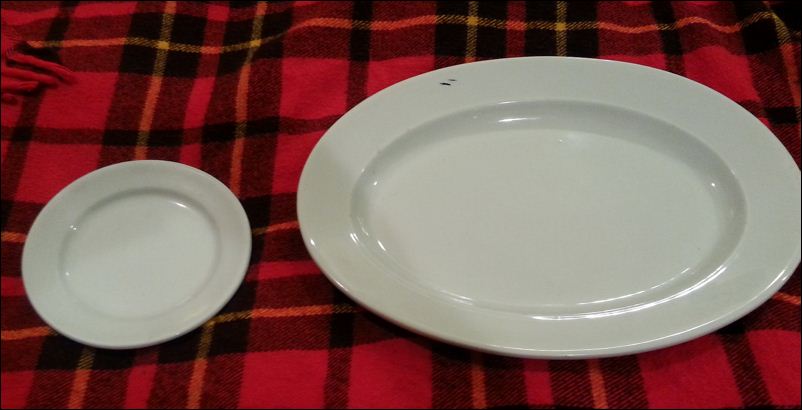
Edward Clarke White Stone China
the plate on the left has the
Longport mark and the platter on the right has the earlier Tunstall
mark
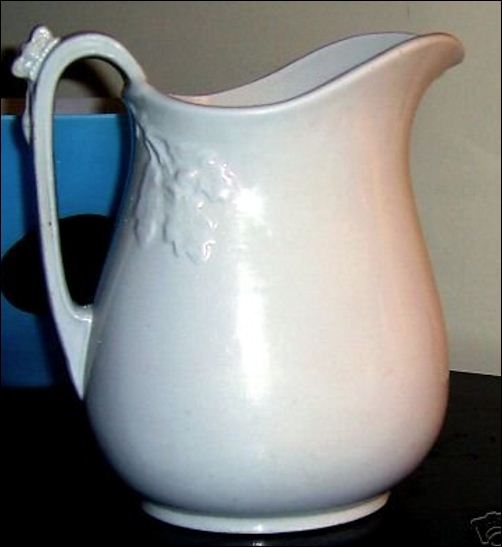
Edward Clarke white ironstone
jug - Longport

White ironstone chamber pot -
Edward Clarke - Burslem
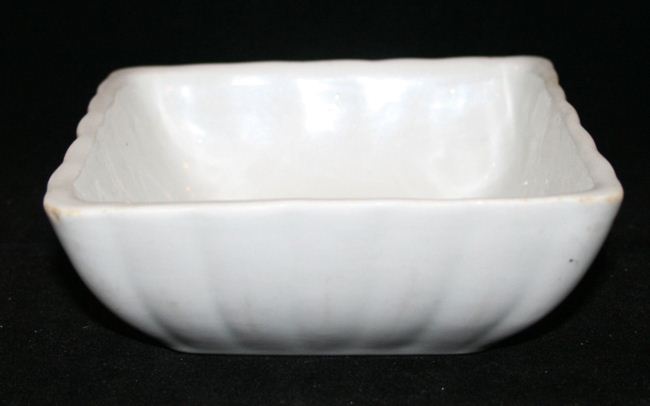
small ironstone dish with the
later Burslem mark
Marks used on ware for identification:
EDWARD CLARKE
EDWARD CLARKE & CO
ROYAL SEMI-
PORCELAIN
PORCELAIN
OPAQUE
STONE CHINA
Often the name of
the town where the factory was located was often
added to the mark and this is a guide to the date of manufacture:
TUNSTALL: c.1865-77
LONGPORT: c.1877-80
BURSLEM: c.1880-87
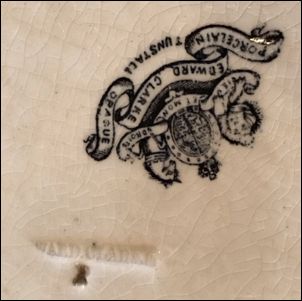
printed: Royal Arms
impressed: Edward Clarke
from a platter found in Annandale, Virginia, USA
courtesy: Leslie Quale
|
c.1865-77 |
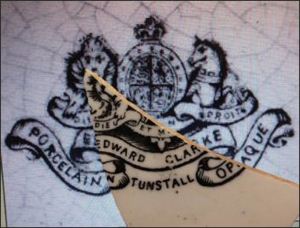 fragment of Edward Clare ware found in San Jose, Calfornia, USA Found at San Jose, just a short distance from what was once
a large mercury mine - the New Almaden Mine (named after the largest mercury mine
in Almaden, Spain). It started operation in the 1840's. photo courtesy: Jim Hannan |
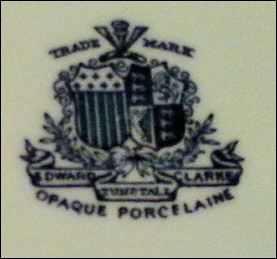
this style of
mark was often used for ware exported to America
the shield on the left represented the stars and stripes of the USA
and the shield on the right is the shield of the Royal Arms of the
UK
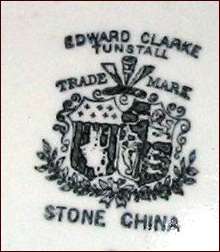 Edward Clarke Tunstall c.1865-77 |
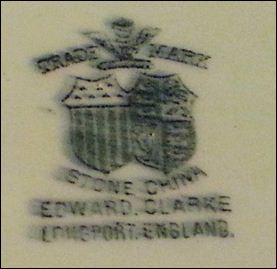 Edward Clarke Longport, England c.1877-80 |
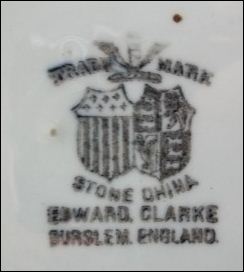 Edward Clarke Burslem, England c.1880-87 |
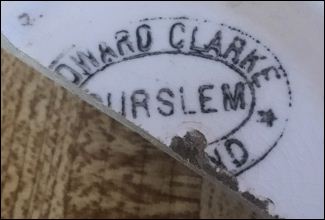
Edward Clarke
Burslem
England
fragment of white ironstone found on an old ranch in California, US
manufactured c.1880-87
 this shard has an impressed 8.73 which is the month.year of manufacture - in this instance August 1873 |

the curled ribbon hanging from the shield shows that this mark is from the Phoenix factory at Tunstall and dates from 1865 to 1877 |
both these shards were found at a rural farm site in Northern California, US,
that had known residents around 1865-1870
photos supplied by: Nathan Blunt
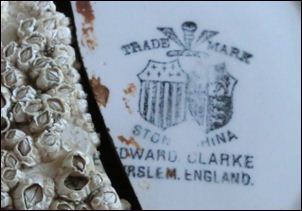
Edward Clarke
Burslem England
manufactured c.1880-87
white ironstone recovered by Chris Welborn diving in Oregon, USA
where the Columbia River empties into the Pacific Ocean.
this area is close to Fort
Stevens
Questions, comments, contributions? email: Steve Birks